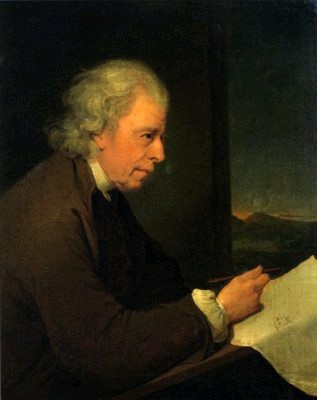<Back to Index>
- Geologist John Whitehurst, 1713
- Poet José Basílio da Gama, 1740
- King of Scots James V, 1512
PAGE SPONSOR

John Whitehurst FRS (10 April 1713 – 18 February 1788), of Cheshire, England, was a clockmaker and scientist, and made significant early contributions to geology. He was an influential member of the Lunar Society.
Whitehurst was born in Congleton, Cheshire, to a clockmaker, the elder John Whitehurst. Receiving only a slight formal education, the younger Whitehurst was taught clockmaking by his father, who also encouraged the boy's pursuit of knowledge. At the age of twenty - one, the son visited Dublin to inspect a clock of curious construction of which he had heard. In 1722 he invented the "pulsation engine", a water - raising device that was the precursor of the hydraulic ram.
About 1736 Whitehurst entered into business for himself at Derby, where he soon obtained great employment, distinguishing himself by constructing several ingenious pieces of mechanism. Besides other works he made the clock for the town hall, and in reward was enrolled as a burgess on 6 September 1737. He also made thermometers, barometers, and other philosophical instruments, and interested himself in contriving waterworks. He was consulted in almost every undertaking in Derbyshire and in the neighbouring counties in which skill in mechanics, pneumatics, and hydraulics was required.
In 1774, Whitehurst obtained a post at the Royal Mint in London. In 1775, on the passage of the act for the better regulation of the gold coinage, without any solicitation on his part he was appointed stamper of the money weights on the recommendation of the Duke of Newcastle. Whitehurst moved to London, where the rest of his life was passed in scientific pursuits, and where his house in Colt Court, Fleet Street, (formerly the abode of James Ferguson) was visited by other distinguished scientists.
In 1778 Whitehurst published his theory on geological strata in An Inquiry into the Original State and Formation of the Earth. The original design of this work, which he began to prepare while living at Derby, was to facilitate the discovery of valuable minerals beneath the Earth's surface. He pursued his researches with so much ardour that the exposure he incurred tended to impair his health.
On 13 May 1779 Whitehurst was elected a fellow of the Royal Society, and in 1783 he was sent to examine the Giant's Causeway and the volcanic remains in the north of Ireland, embodying his observations in the second edition of his Inquiry. About 1784 he contrived a system of ventilation for St. Thomas's Hospital (Bernan's History and Art of Warming and Ventilation, 1845). In 1787 he published An Attempt towards obtaining invariable Measures of Length, Capacity, and Weight, from the Mensuration of Time (London). Starting on the assumption that the length of a second pendulum in the latitude of London was 39.2 inches, he deduced that the length of one oscillating forty - two times a minute is eighty inches, while that of one oscillating twice as many times is twenty inches. The difference between these two lengths would therefore be exactly five feet. He found, however, upon experiment that the actual difference was only 59.892 inches owing to the real length of the pendulum, oscillating once a second, being 39.125 inches. He obtained roughly, however, data from which the true lengths of pendulums, the spaces through which heavy bodies fall in a given time, and many other particulars relating to the force of gravitation and the true figure of the earth, could be deduced.
On 9 January 1745 Whitehurst married Elizabeth Gretton, daughter of George Gretton, rector of Trusley and Dalbury in Derbyshire. After Whitehurst died in 1788 at his house in Bolt Court, Fleet Street, he was buried beside his wife in St. Andrew's burying ground in Gray's Inn Koad. There were no surviving children.
It has been suggested that Whitehurst is the model for Joseph Wright's picture of a philosopher lecturing on the orrery.